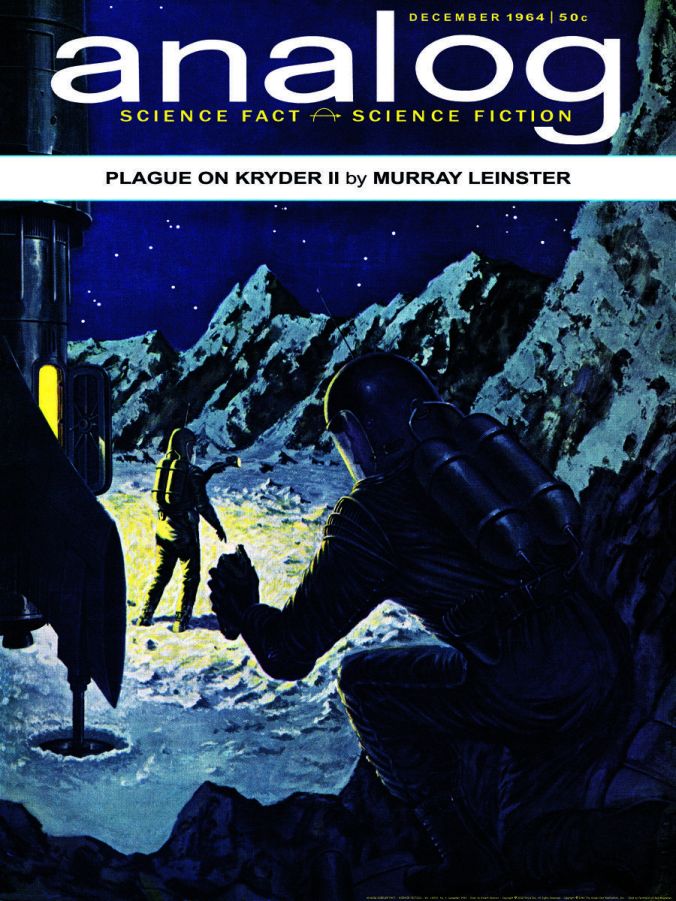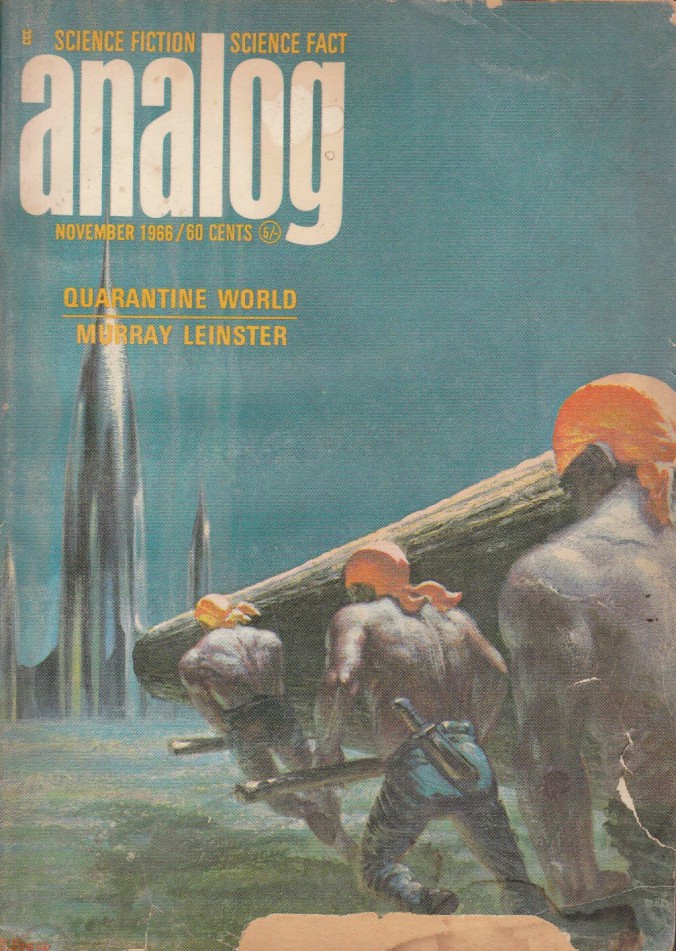4/5 (collated rating: Good)
In times of stress, positivist stories about spacemen devoted to selfless service solving medical crises with their friendly tormals (think furry mobile petri dishes) bring a bit of warmth to my bitter heart. While a medical mystery to be solved with logic and resolve forms the core of each story, Murray Leinster hints at the future history of this decentralized spacescape–a product of chaotic often business-driven expansion. As limited contact exists between distant colonies, The Interstellar Medical Service attempts to guarantee the survival of the human race and right various forms of societal and economic oppression. Quoting (with slight modification) Richard Derus, friend of the site, Leinster argues that “supernational institutions can do less harm, more good, and the greatest threat to happiness and health is [unchecked] capitalism” and ignorance.
Each Med Service story I read contains wonderful psychological insights into human behavior and rich details of space survival. This collection is superior to Doctor to the Stars (1964). If you find it in a used bookstore, snag a copy. Due to the solid overall quality of the stories in the sequence, the more recent Med Service omnibus editions might be better bang for your buck (bibliographical listing).
If you need a 2020 pick-me-up, I recommended checking out Murray Leinster’s Med Service series.
Brief Plot Summary/Analysis
“Plague on Kryder II” (1964), 3.75/5 (Good) first appeared in the December 1964 issue of Analog, ed. John W. Campbell, Jr. Calhoun and Murgatroyd set off to solve yet another medical emergency (with the terrifying news of tormal casualties) on the planet Kryder II. But someone wants them dead on arrival! The Esclipsis Twenty exits overdrive with false data inputted to its screens: “outside the ship there was nothing even faintly corresponding to the look of things from within” (11). Suspecting further booby traps, Calhoun hides on his ship as it’s searched. A plot takes shape–someone wanted to pretend to be a med man with his tormal as proof!
Leinster’s exploration of strategies to prevent med men from going insane due to the emptiness of space make “Plague” even more appealing. Leinster posits that interstellar travel might create a “psychosis of solitude” (23) in its travelers. Small “random noises” (conversation, faint music, rain and wind) wisp through the Esclipsis Twenty to fill the silence (14). In “Quarantine World” (1966) (reviewed below), Leinster describes the sounds as “sensory assurance” (98). Tormals, more than necessary generators of antibodies, also provide needed companionship as they “adore[…] being noticed by a man” (23). Keen psychological details like this add a rich texture to Leinster’s world.
“Ribbon in the Sky” (1957), 4.25/5 (Good) first appeared in the June 1957 issue of Astounding, ed. John W. Campbell, Jr. Easily the best Med Service tale I’ve read so far, “Ribbon in the Sky” presents yet another compelling medical mystery on an alluring world. An error causes Calhoun and Murgatroyd to arrive on an unknown planet abandoned by the corporation that funded its colonization. The surviving inhabitants, suffering from the pathological symptoms of “isolation syndrome” (59), eke out a living in three settlements ensconced in the icy expanse. Suspicious of both outsiders and inhabitants of the other settlements, the survivors believe that each community has its own transmittable disease. An exogamic impulse between young lovers gives Calhoun an idea to bring stability to the world….
I am a sucker for stories that speculate on the psychological effects of isolation, the “classic Crusoe problem” (63), in a future venue. This particular brand of crisis appeared primarily in the earlier days of “chaotic” galactic migration as entrepreneurs “grew rich in the establishment of the new settlements” but had little interested in “maintaining them” (63). Leinster’s vast spectrum of isolated colonies and tenuous connections serves to highlight the importance of governmental oversight by well-meaning, if beleaguered, agencies and agents.
“Quarantine World” (1966), 4/5 (Good) first appeared in the November 1966 issue of Analog, ed. John W. Campbell. This story expands on Murray Leinster’s basic view that capitalism must be constantly checked by the government. On a routine medical check of the planet Lanke, Calhoun becomes increasingly suspicious that the Health Minister isn’t telling the entire truth. After Calhoun’s canned speech on the importance of modern science contributing to the economy, a man is murdered outside the meeting! Catching a glimpse of his poor dental care and facial scar tissue, our med man sniffs out a mystery–where did this man come from? Why weren’t his illnesses professionally treated? And why was he killed?
Calhoun ascertains the origin of the dead man and that there’s a plague afoot and the businessmen “on Lanke want it hidden” to prevent a quarantine (94). Apparently a routine problem, as “it wasn’t unprecedented for planetary governments to try to cover things up that would be bad for business” (96), the human loss could be “incalculable” (97). As the med ship flees from the planet, Calhoun feels the disease take hold. He wakes on the planet Delhi, the dead man’s home world, with his ship stuck in a vile bog. And the inhabitants of this world, cut off for generations, deeply distrust him.
For cover art posts consult the INDEX
For book reviews consult the INDEX
For TV and film reviews consult the INDEX






Oh boy…this one’s got all my fingerprints on it. Thanks for the shout-out!
No problem and thanks for all the conversation! Whenever I attempted to write a sentence encapsulating his views of capitalism post-Great Depression, I realized that I was simply rephrasing what you said in the comments on my review of Doctor to the Stars (1964) — sometimes a quote, and a good one at that, works best!
Heh…pithy aphorisms Я me…